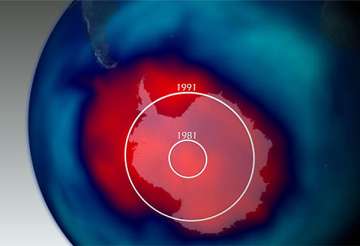Washington, Oct 16: The first significant ozone hole above the Antarctic is now as big as North America, scientists have claimed.
Spanning about 25 million square kilometres, the ozone hole over the South Pole reached its maximum annual size on September 14, becoming the fifth largest on record, they said.
The largest Antarctic ozone hole ever recorded occurred in 2006, at a size of 27.5 million square km, a size documented by NASA's earth-observing Aura satellite, LiveScience reported.
The Antarctic ozone hole was first discovered in the late 1970s by the first satellite mission that could measure ozone, a spacecraft called POES and run by the National Oceanic and Atmospheric Administration (NOAA).
The hole has continued to grow steadily during the 1980s and 90s, though since early 2000 the growth reportedly levelled off. Even so scientists have seen large variability in its size from year to year.
Intense cold in the upper atmosphere of the Arctic last winter activated ozone-depleting chemicals and produced the first significant ozone hole ever recorded over the high northern regions, the scientists reported in journal Nature.
On the earth's surface, ozone is a pollutant, but in the stratosphere it forms a protective layer that reflects ultraviolet radiation back out into space, protecting us from the damaging UV rays.
Latest World News
